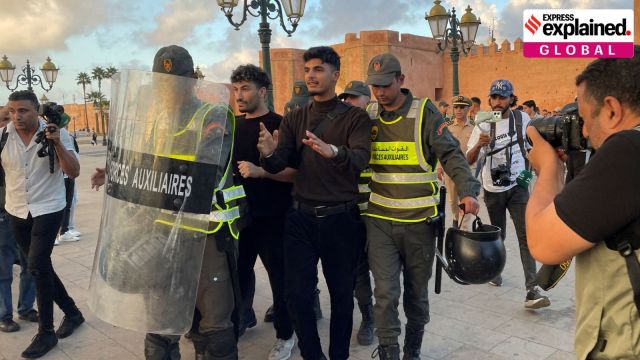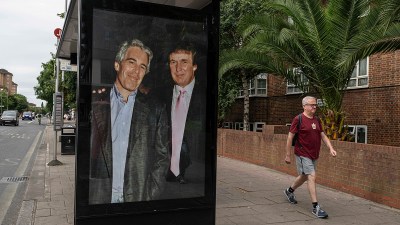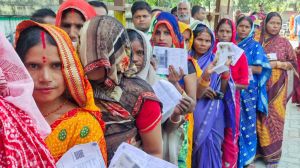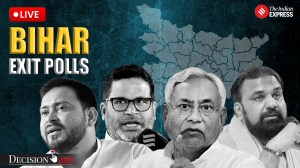After Indonesia, the Philippines and Nepal, youth-led protests (often dubbed “Gen Z protests”) have been witnessed in recent days in the North African nation of Morocco and the Indian Ocean island of Madagascar. On Sunday (October 12), the Madagascar presidency said that “an attempted illegal and forcible seizure of power” was underway.
All of the agitations have had different triggers, but some similarities — social media-led mobilisation, the participants often being from younger age groups, and grievances with the ruling establishment over quality-of-life-related issues.

Janjira Sombatpoonsiri, a Research Fellow at the German Institute for Global and Area Studies, who studies social movements and digital spaces, told The Indian Express, “These countries share the dynamics of extreme imbalance of power and resources between a handful of elites and the rest of the population. They are parts of retreating middle-income countries affected by the loss of manufacturing jobs that used to drive post-World War 2 industrial countries like Korea or Japan.”
Story continues below this ad
“Yet, young people are told the same industrial mantra that they need to get college degrees to have better lives than their parents. When this doesn’t happen, they are understandably frustrated,” she said.
Here is what to know about the latest set of agitations, their place in the long history of youth-led agitations and where they differ.
MOROCCO
The trigger: According to the Associated Press, demonstrations have continued in more than a dozen Moroccan cities for over 10 days now. In late September, the death of eight women during childbirth in a hospital in the town of Agadir first sparked agitations.
The lack of quality public services was juxtaposed with the government pouring billions into building stadiums for the FIFA World Cup, which Morocco will host with Portugal and Spain in 2030. Among the protestors’ chants was “Stadiums are here, but where are the hospitals?”
Story continues below this ad
The people: A leaderless collective called Gen Z 212 (the number being Morocco’s dialling code) is at the helm, with the messaging app Discord being a popular medium for communication. It was also the choice of protestors in Nepal.
The context: Morocco is a constitutional monarchy. More than half of the population is under 35, but unemployment in the 15-24 age group has climbed to 36%, the AP reported. Morocco’s per capita GDP as of 2024 was $3,993, while the global average was over $13,000.
Poverty reductions have happened over time, driven by employment in industries such as tourism, but the present discontent has more to do with income inequality.
Gen Z 212 has asked King Mohammed VI to dismiss the government and demand accountability from officials, while security forces have at times unleashed crackdowns and mass arrests. After several days, Prime Minister Aziz Akhannouch said the government was open to dialogue and suggested improving the state of medical services. On Friday, the monarch called for accelerating reforms to create jobs for young people, improve public services, and reduce regional inequalities.
Story continues below this ad
MADAGASCAR
The trigger: Several power and water cuts in September led to protests that the government sought to put down, resulting in the deaths of over 20 people. It led to the protestors criticising the entire establishment, with the resignation of President Andry Rajoelina now a key demand.
The people: According to a CNN report, the protests began as a youth-led movement known as Gen Z Mada, which first coordinated over Facebook and TikTok. Later, they tied up with civil society groups and trade unions.
The context: About 50% of Madagascar’s population is under 18. The country has a per capita GDP of just $545, with more than three-fourths of the total population living below the poverty line. Reuters reported that income per capita has actually fallen 45% between independence from France in 1960 and 2020.
Rajoelina fired his cabinet last week, but demonstrators are now also calling for his resignation.
The common threads
Story continues below this ad
Other recent protests have highlighted similar problems, be it the elite cornering opportunities in Nepal and the Philippines (leading to slogans mocking “nepo” kids or the children of the elites), or economic woes in Indonesia. Although only Nepal saw the protests result in a change of government.
In the past, too, young people have been at the forefront of everything from anti-war protests in the 1970s in the United States to demonstrations against authoritarianism in Hong Kong in the 2010s. It is often because people begin to formulate their own ideas about politics and the world in their youth, and have relatively more time to spend on political action. They also see their future as directly impacted by policies.
In their book Youth Without Representation (2022), authors Aksel Sundstrom and Daniel Stockemer note that a sense of grievance may also stem from a lack of representation in legislative bodies in many countries. In India, for example, the average age of Lok Sabha MPs was 56 in 2024, while the average age of Indians is 27.8 years old, according to the 2011 Census.
Some recent data have also shown less political engagement among the youth than previous generations, as seen in lower news consumption and lower voting participation, especially in the West.
Story continues below this ad
In the case of the recent protests, social media has helped address issues that turned out to be common concerns globally. Sombatpoonsiri said that compared to past protests, what has changed is how young people organise for collective action.
“Social media platforms allow for rapid communication and coordination, but the downside is that “fast mobilisation” lacks longevity. Their demands for social change require persistence and long-term engagement in advocacy rooted in a broad-based coalition — something that quick and decentralising online organising can struggle to sustain. This explains why, despite a steady rise in the number of protests (largely facilitated by social media platforms), many movements have struggled to achieve their stated goal,” she said.
The root causes also have commonalities across regions. “The political elites have done very little to alleviate the economic plight. They concentrate wealth and power in their familial and party networks, entrenching the dominance of their political dynasties. Their self-entitlement means that they care very little about the public when flaunting wealth on social media. All of this has enraged young people across countries,” said Sombatpoonsiri.








































